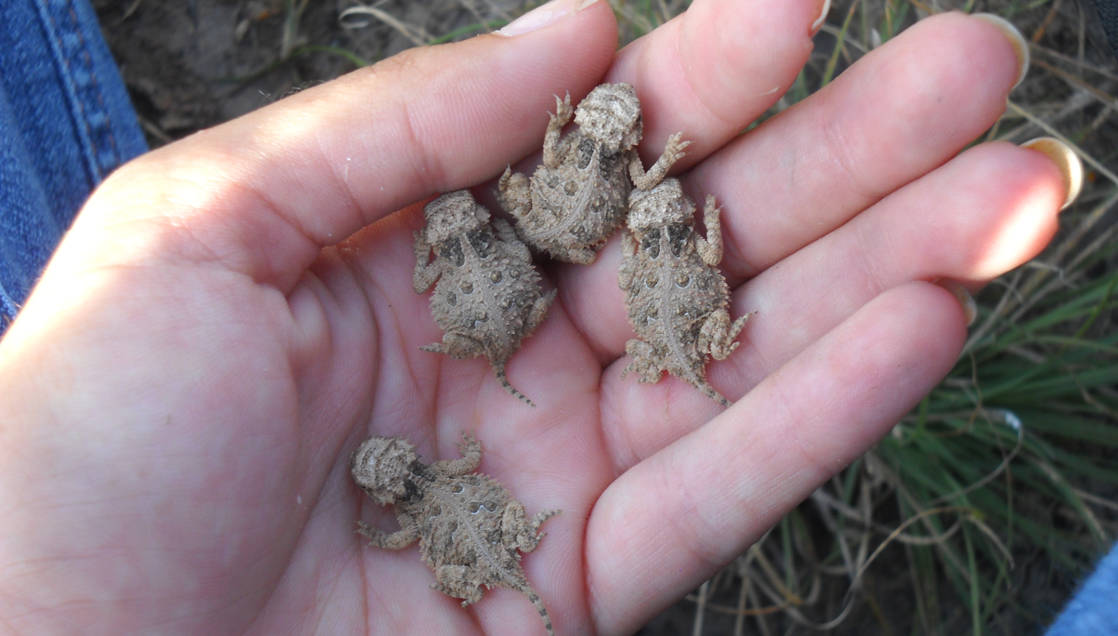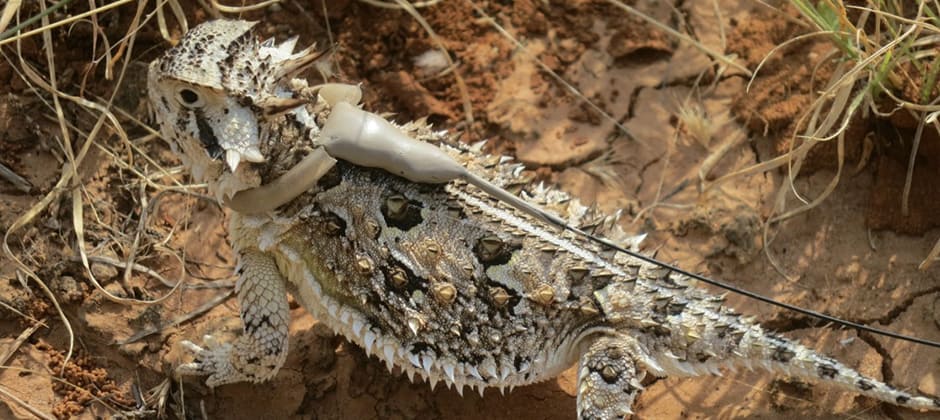Share this article
JWM: Translocated horned lizards face new hurdles
Researchers working to translocate declining Texas horned lizards across parts of their former range are working to overcome challenges brought about by changes on the landscapes they once occupied.
Texas horned lizards(Phrynosoma cornutum), sometimes called horny toads, were once ubiquitous across the state. Known for their thorny appearance, these reptiles are also famous for their ability to shoot blood from the corner of their eyes as a defensive tactic.
But habitat loss and land use change caused the lizards to disappear from the eastern parts of their range, in Texas and Oklahoma. The spread of invasive fire ants (Solenopsis spp.), which outcompete the native harvester ant species that horned lizards eat, may also play a part in the lizards’ decline.
“[The lizards were] a really important part of our lives growing up, and now we never see them,” said Jesse Meik, an associate professor in biological sciences at Tarleton State University in Texas and one of the co-authors of a study published recently in the Journal of Wildlife Management.
While it’s sometimes difficult to get the public to back up projects that focus on “creepy-crawly” species, these lizards are “iconic” in the state, Meik said.

Texas horned lizards reintroduced to the Muse Wildlife Management Area successfully reproduced each year of the study. ©Kelly Miller
“Texas horned lizards are so important for Texas’s identity,” Meik said. “Everyone loves them.”
Many people wanted to see them return to parts of their former range where they had been extirpated. Meik and his team settled on the Muse Wildlife Management Area southwest of Dallas to conduct a pilot study on restoring the species from 2014 to 2016.
They first removed cedar and oak trees that crept into parts of central and eastern Texas and seemed to negatively impact the lizards. They restored the reintroduction area to midgrass prairie, which better supports the reptiles.
After collecting adult lizards in areas of western Texas where horny toads are still very common, they fitted tiny radio transmitters on collars made from plastic tubing and fishing line and put them in soft-release enclosures for 10 days to let them acclimatize.
After the researchers opened the enclosures, they tracked the lizards every day at the beginning of the project, then at least once a week thereafter.
They found that many lizards were killed — mostly by coachwhip snakes (Masticophis flagellum). When the researchers tracked lizards in the brush, they often found they were actually chasing a coachwhip that had eaten the lizard, tracking device and all.
Part of this may have been due to the fact that some piles of brush left over from habitat clearing weren’t cleared, providing ideal hiding places for snakes, Meik said. Or the horned lizards from western Texas may be naïve to their surroundings and more vulnerable to predators there as a result.
Survivorship in the first year of the study was comparable to that shown by other studies of the survivorship of lizards in natural, non-translocated populations. But this survivorship declined over the years.
Meik said this was possibly because midgrass prairie areas were not maintained throughout this period and may have reverted to less suitable habitats for the lizards.
They did find that the lizards that survived had good body conditions, indicating that they were finding enough food in the area. While more research is needed, Meik said, this may mean that fire ants aren’t the primary reason for the lizards’ disappearance in parts of their former range, since these ants are still present in the Muse area.
But Meik said that one of the promising parts of their reintroduction pilot program was that the reintroduced lizards manage to reproduce every year, nesting and successfully hatching young. They also noticed that while the lizards prefer midgrass prairie, they seemed to need some woody area to hibernate under certain trees during the winter.
Researchers hope to try reintroducing lizards hatched in captivity to see if it would improve their survival.
This article features research that was published in a TWS peer-reviewed journal. Individual online access to all TWS journal articles is a benefit of membership. Join TWS now to read the latest in wildlife research.
Header Image: A Texas horned lizard fitted with a tracking device was reintroduced to eastern Texas. ©Kelly Miller








